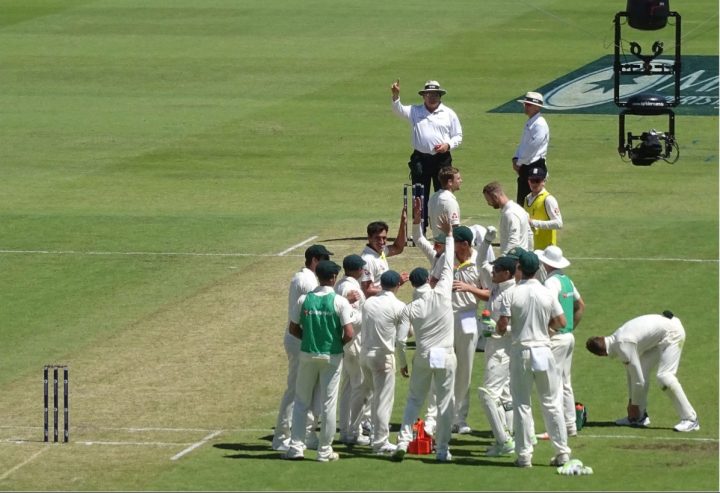And as you can imagine, that’s up against some pretty stiff competition.
Last week, the chief executives of the senior cricket nations gathered under the auspices of the ICC to discuss how the game is run and managed. Their implicit task was to devise ways to enhance and reform the sport.
Now, if you were to come up with an idea to improve cricket, what might it be? More grass-roots investment? A better balance between bat and ball? Fewer meaningless fixtures?
Well here’s what the ICC bigwigs came up with: more DRS.
As you may have read, the governing body will from 1st October trial a new system in which teams receive an extra two additional reviews after eighty overs of an innings.
You have to admit, they’ve really nailed it there. I’ve lost count of the number of times I’ve heard a cricket fan say to me, “I really wish there were more DRS reviews in test cricket”. It really is what every supporter’s been crying out for, isn’t it? More interruptions, more delays, more pointless reviews by batsmen with nothing to lose.
What on earth were the chief execs thinking? What was the process by which they decided test cricket needed more reviews? Who’s been asking for this, who’s campaigned for it, who’s ever suggested we currently have too few? Of all the problems they could have addressed, they’ve decided to expend all their energies on an invented one.
If anything, the number of reviews should be reduced – to one – not increased. The aim of DRS remains to eradicate the terrible howler, and to my mind a single review is perfectly adequate – because you would only review if absolutely convinced the decision was wrong.
If you’ve read this blog before, you may have noticed that I often rail against the failings of DRS. Many of you disagree with my arguments. But even the staunchest advocate of DRS would concede that for the system to work, less is more.
The success, or otherwise, of any umpiring system is gauged by its unobtrusiveness, for it is only a mechanism to support the game, not the game itself. Axiomatically, the fewer reviews the better. But now, any team with reviews remaining after 70 overs will burn them on ridiculous appeals, safe in the knowledge that they will be replaced along with the new ball.
One can only fear how the ICC’s grasp not only of cricketing logic, but sheer common sense, might manifest itself in future. What other problems will they identify next? Not enough sixes being hit in the IPL? Too few tests ending in a draw? Sachin Tendulkar not sufficiently popular in India? After their next meeting, it wouldn’t particularly surprise me if we ended up playing with a square ball.










Morgs here. I am fan of DRS overall, as the standard of umpiring is terrible, and we would’ve had even more wrong decisions in the Ashes had it not been for DRS. However, what I object to is the new ‘game within the game’ that DRS has created i.e. if one side ‘uses DRS better’ then they get a pretty important advantage. This can’t be right, can it?!
I obviously watch a lot of cricket on TV, and to be completely honest, I’ve decided that there’s no such thing as ‘using DRS well’. It’s basically a crapshoot. The captain has no idea whether the ball pitched outside leg, or outside the line of off, on LBW decisions. He can only really guess from his view at 2nd slip. The keeper gets a better view, but the keepers get it wrong more times than the umpire! So why rely on the keeper to challenge the umpire’s view? It makes no sense.
Think about your own experience playing cricket for a sec. How times have you been batting when the fielding side goes up for a huge caught behind appeal. They’re genuinely 100% convinced you’ve hit it (the umpire might even give you out), but you -as the batsman – know that it’s grazed your sleeve, not your glove. Basically, the fielding side can only go on gut instinct, which is often wrong. My point? Basically DRS is just semi-educated guessing – and there should be no place for guessing games in a test match.
Then there’s the hotspot farce; it only works reliably in cold weather. Plus the stupid rule that to overturn LBWs, more than half of the middle of the ball needs to be hitting more than half of the middle of the stump – therefore, a ball could be cannoning into legstump, at an angle that would knock the bloody thing for six, yet the decision still stands as ‘not out’.
It seems to me that the ICC should be concentrating on improving the use of DRS, and professional umpire’s ability to interpret the technology for inside edges etc, rather than simply increasing the number of challenges in a test innings. Therefore, I think Maxie is basically spot on in his article. How does increasing the number of challenges actually ‘improve’ the system? It just increases the number of ‘tactical’ reviews and entrenches this unsavoury ‘game within a game’.
Personally, I would be tempted to scrap DRS for LBWs unless it’s a matter of whether the ball pitched outside the line, or outside leg i.e. where it’s pretty clear cut. I would then get rid of hotspot (an ‘aid’ to the umpires isn’t good enough in my view) and fast-track real time snicko to rule on inside edges and caught behinds. The technology needs to be improved, and the system tinkered with. Simply increasing the number of challenges does little to solve the overall problems.
They had to make a choice whether DRS is a last resort for the very occasional howler, or whether you effectively want to refer every decision.
As Maxie said, if it’s the former the logical thing is that you only have one referral. By increasing the number rather than reducing it they’ve started towards the latter. Eventually it will be like run-outs: even when the batsman’s two yards short the umpire calls for a review because they’re told ‘the technology’s there so use it’ and, of course, they aren’t brave enough to make a wrong decision now that they can refer every line call. The same will happen for every other decision.
Maybe the Indians were right.
I would say reduce it to one, but don’t count it if it rules as now “Umpire’s Call”
At the moment it punishes teams who were perhaps right for making the “wrong” referral as much as it punishes someone who makes a stupid referral when there is no doubt that the original decision was right.